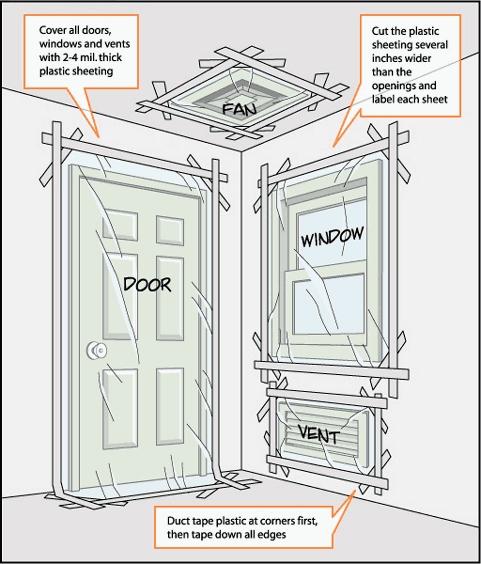In some emergency situations staying put might be the best option. Several factors come into play if you decide to stay in place. Primarily, you need to be focused on whether the existing structure you’re in is secure enough or can be made secure enough to withstand whatever the event may be. Sheltering-in-place means to take temporary protection in a structure or vehicle typically your workplace or residence or even your car. I mention ‘temporary’ as in most cases, the aftermath of a disaster will severely compromise the integrity of a structure. Preparing your residence for this eventuality is your responsibility.
There are actually three sub-categories within the Shelter-in-place definition.
Shelter up is where you fall back to the upper floors of the structure such as the 2nd floor or attic, in the event of flooding.
Shelter in is where you remain on the main or ground floor of the structure and attempt to create a barrier between you and a potentially contaminated atmosphere outside. The same method that is used to cut plastic sheeting for doors and windows could be used by someone who lives in a hurricane prone area to cut wood for the exterior doors and windows.
Shelter down is when there is a tornado or high wind warning and the safest location would be a basement or interior room with few windows and doors.
The problems with at least two of these methods are that the majority of your supplies will be on the main floor or basement of your residence and you’ll be cut off from them if the event lasts beyond the predicted time frame.
You will need to adjust your shelter-in-place procedures according to the type of building you are in. For example, if you live in a high-rise apartment, you will need to go to the base or ground level of the apartment complex instead of staying in your actual apartment during a tornado alert.
This is where a home E-kit comes into play. An E-kit or Emergency Kit, Bug out Bag, Get Out of Dodge Bag, Go-bag, or whatever name you prefer to call it comes in handy. A shelter-in-place E-kit is a small kit that contains enough equipment and supplies to last you for at least 5 days (More is always better but space considerations come into play with larger kits). What makes this particular kit different is that it’s designed for use inside a structure and would rarely if ever be used outside that structure.
The major benefit of sheltering in place is the close proximity to the rest of your supplies and that in most cases the event that requires you to remain inside is normally short-lived.
Referring back to the core topic behind this group, there was a topic that was a list of items that could be gathered over a 24 week time frame (the 24 Weeks of Preparedness post). If you divided those items in half and placed half into sturdy containers, not cardboard boxes, you could move those containers with you if you had to shelter up or down. My preference for this is the Rubbermaid Roughneck containers as they have a smooth bottom and can slide on carpeting fairly easy. Of course any container will do as long as it’s easily moved and sturdy enough to handle the movement. Even a hard sided rolling suitcase or trunk would work in this situation. This makes it quick and easy for just about anyone to be able to move them in a hurry requiring only some assistance to get them upstairs or down.
Some people prefer to use a gym bag, a military surplus duffle bag or a pre-packaged kit. As with all stored supplies, you will need to check them every 3-6 months and change out expired, swollen or dented cans. Never store batteries inside any of the devices that may be inside your home E-kit.
You should know how to turn off the utilities such as water, gas, heating, ventilation and air-conditioning systems and close and secure all doors, windows, vents and other exterior openings.








